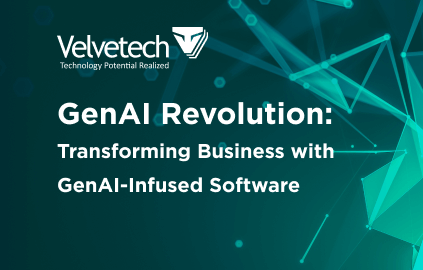Artificial intelligence is taking the business world by storm. Thus, making it more important than ever for organizational leaders to understand this advanced technology.
After all, if you want to leverage this innovation for your firm and pursue AI software development, it’s important to know some of the basics around what it can do.
Hence, in today’s post, we will discuss the types of artificial intelligence that are out there. This way, you can be aware of the common terminology and determine what AI-based software you can implement to improve business performance.
The truth is, there are multiple ways for the different types of AI to be classified. Often, it just depends on the context within which you’re discussing it. Since it can get confusing to navigate the various terms, we’ve decided to focus on the three most common categorizations:
So, without further ado, let’s dive in.
GenAI for Business
Watch our webinar to uncover how to integrate GenAI for improved productivity and decisions.
Technology-Based AI Types
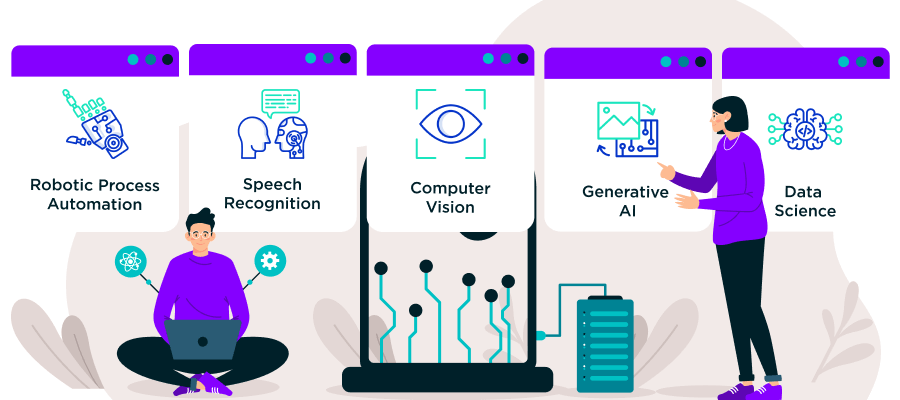
The technology-based categorization is likely one of the most well-known ones in business circles. It is also sometimes known as the different subsets or subfields of artificial intelligence and essentially relates to the various techs involved in effective AI solutions.
In this section, we will focus on covering the five main types — robotic process automation, speech recognition, computer vision, generative AI, and data science.
Robotic Process Automation
Robotic process automation, or RPA, includes immensely powerful solutions that many businesses are already leveraging today. As the name suggests, the main goal of this technology is to automate repetitive tasks and carry them out without human intervention with the help of artificial intelligence or metaphorical software robots.
Typically, RPA can be implemented to help process transactions, manage data, create reports, trigger responses, and even interact with other enterprise software. Thus, the common benefits that RPA systems deliver are:
- Error-free operations
- Increased productivity
- Reduced costs
- Improved customer experience
Overall, RPA is a technology that helps companies tackle many operational challenges and transform into truly digital businesses. So, it’s definitely an area of AI that shouldn’t be overlooked by leaders aiming to streamline their processes and improve efficiencies.
Learn more about Robotic Process Automation
Speech Recognition
Speech recognition programs are those that process human speech into textual format. They are, however, not to be confused with voice recognition systems. Since the latter solely aims to identify an individual’s voice, not convert it into written form.
Overall, AI-powered speech recognition software is a robust tool that can integrate grammar, syntax, structure, and composition of audio and voice content to process human speech.
Discover the Top 5 Benefits of Speech Recognition Software
However, due to the vague and complex nature of the human language, this is one of the most challenging areas of AI. In fact, various algorithms and computation techniques have to be relied on for accurate speech-to-text transcription. Specifically, systems often depend on natural language processing, neural networks, and speaker diarization to effectively carry out the set out tasks.
Firms from all kinds of industries can benefit from speech recognition software, especially if they want to incorporate intelligent contact centers into their sales or customer service departments. In this context, agents can be empowered with dynamic scripts thanks to speech-to-text-transcription and dialogue visualization. Thus, allowing them to tackle issues faster and close a larger amount of deals.
Learn how our AI Call Center Solution Boosted Insurtech Company Sales
If we get a tad more specific, in healthcare, speech recognition technology can be great for doctors and nurses who can rely on dictation apps to record patient diagnoses and treatment options. Thus, speeding up administrative work and allowing medical professionals to focus on actual patient care.
As you can see, there is a lot of value in speech recognition solutions for enterprises. So, don’t put off looking into this area of development and get ahead of your competitors.
AI-Based Contact Center Product Suite
Full-featured Inbound & Outbound call center with AI-based agent scoring and call analytics.
Computer Vision
Computer vision systems leverage artificial intelligence to process digital images, videos, and other visual inputs to extract meaningful information that can serve as a basis for decision-making.
Similar to human eyesight, computer vision aims to tell objects apart, identify what they are, whether or not they’re in motion, and so on. However, thanks to AI, it can inspect thousands of images in seconds and spot issues way faster than most human eyes may be able to.
In the business context, computer vision is popular within various industries. For manufacturing, it can be used to automate product assembly lines, detect defects in the production line, manage inventory levels, and even monitor machinery to forecast maintenance needs.
In healthcare, there are also many benefits that computer vision delivers. From accurate and efficient medical image analysis to better patient identification and improved adherence to safety standards — there are many ways to leverage the technology to boost treatment delivery.
So, no matter the sector you come from, consider implementing computer vision software into your processes. It might surprise you in the best possible way.
Generative AI
The next one of the artificial intelligence types that we certainly can’t skip in this article is generative AI. It has created so much buzz in the tech and business worlds that you probably heard about it a lot. But GenAI is more than just a buzzword, of course. It drives immense value across various business functions and domains.
Generative artificial intelligence is a cutting-edge technology that harnesses the power of machine learning to produce new content, mimicking and sometimes surpassing human creativity. Unlike traditional AI systems that rely on predefined rules, GenAI has the ability to generate original and diverse outputs — images, text, sounds, or even entire scenarios.
Businesses turn to generative AI development services to cover different needs. From task automation and business process optimization to employee and customer assistants. For example, with GenAI, you can provide personalized recommendations for customers or create immersive virtual environments for training simulations. The possibilities are really vast.
“77% of respondents expect generative AI to have the largest impact on their businesses out of all emerging technologies”.
To harness the transformative power of generative AI, you need not to postpone its adoption. At the same time, as with any new technology, incorporating GenAI requires thoughtful planning and risk mitigation. When done properly, this type of artificial intelligence opens doors to unparalleled creativity and problem-solving.
Data Science
The terms data science and artificial intelligence are often used interchangeably to describe technologies that process data and extract insights from it. However, data science doesn’t actually equal artificial intelligence.
In fact, it’s way more focused on pre-processing analysis, predictions, and visualizations as opposed to AI where algorithms are created to mimic human intelligence and foresee events. So, with data science, your organization will be able to:
- Assess the quality of existing data
- Clean and streamline datasets
- Organize and structure digital information for analysis
- Form hypothesis and run experiments
- Transform data into interactive and intuitive dashboards
- Create data warehouses and data lakes
- Develop an efficient data-driven ecosystem
- Protect critical digital information from leakage, modification, and destruction
For many companies, embracing data science often has to start with legacy system modernization. After all, you can’t make the most of innovative technologies if you have outdated software that can’t effectively process and store data.
Learn how Velvetech Modernized Legacy Systems for a Plants Growing Company
Project Estimates
Watch our webinar to learn about the practical ways to evaluate your software project estimates.
Functionality-Based Types of AI
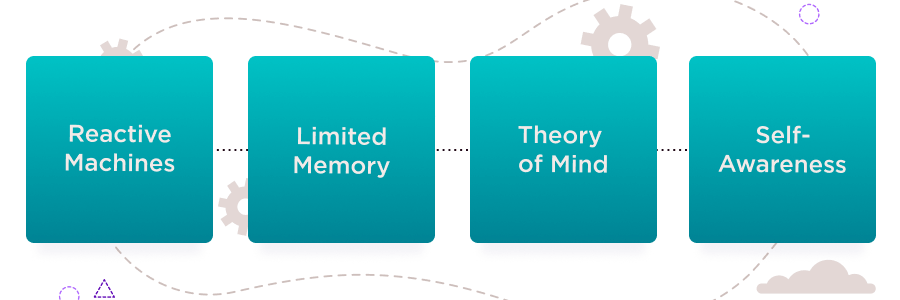
As the name implies, this classification breaks down the different types of artificial intelligence software based on the function that they perform but also places an emphasis on the machine’s similarity to the human mind.
Thus, resulting in four main sub-categories — reactive machines, limited memory, theory of mind, and self-awareness. Let’s take a closer look at each one of them.
Reactive Machines
Reactive machines are considered to be the most basic type of an AI solution. They don’t learn from past experiences or form memories. Instead, they only react to current conditions. So, they hold no memory-based functionality.
One of the most widely known and earliest examples of a reactive machine is Deep Blue. IBM’s chess-playing supercomputer that was created to play against a human competitor and famously won over Garry Kasparov, a chess grandmaster.
In short, reactive machines are made to act here and now, not make inferences about the future or deduct learnings from the past. Hence, these systems usually only perform the basic tasks for which they’ve been programmed. Nothing more, nothing less.
Limited Memory
Limited memory AI refers to models that have some memory retention capabilities but to a limited extent. So, unlike reactive machines, they are able to derive knowledge from past data and learn from it to make optimal decisions.
Most of the existing AI applications fall under the limited memory category. Whether it’s self-driving cars that we keep hearing about or virtual chatbots and image recognition systems — all of these solutions employ a form of limited memory AI.
Let’s elaborate a bit more on one of the examples. In the case of image recognition, AI software is trained using a vast amount of images and labels. That way, it is taught to identify scanned objects. Then, the training images are used as references for every new one that needs to be evaluated, and the AI, based on its “experience”, identifies the new images and objects within them with a high degree of accuracy and speed. Thus, simplifying the entire process.
So, limited memory AI completes more complex classification tasks and can use historical data to identify trends and make predictions about what’s to come.
Theory of Mind
Now, we’re moving on to the types of AI that aren’t abundant in the modern world. Theory of mind AI is one such example since many researchers are currently focusing on developing these programs.
Theory of mind AI refers to a machine’s ability to make decisions in a manner that humans do. Specifically, to be able to understand and recall emotions and adjust behavior based on those elements, just like humans do in most social interactions. It is the next frontier of technology and one which we haven’t quite reached yet.
If, or rather when, theory of mind AI is achieved, these systems will be able to act in an emotionally intelligent manner, hold conversations relative to human standards, and even serve as companions for people.
Self-Awareness
The last type of functionality-based AI we’ll discuss today is self-aware AI, which just like the previous category we covered — doesn’t exist yet.
As the name suggests, these are the machines that have a human-level consciousness and have developed self-awareness. So much so that they’re able to recognize and replicate human actions, think for themselves, have their own desires, and discern feelings.
Self-aware AI is essentially a step beyond theory of mind, in that the machine is self-guided through its thoughts and actions. Thus, very closely resembling the robots you may have seen in some dystopian movies.
Capability-Based Types of Artificial Intelligence
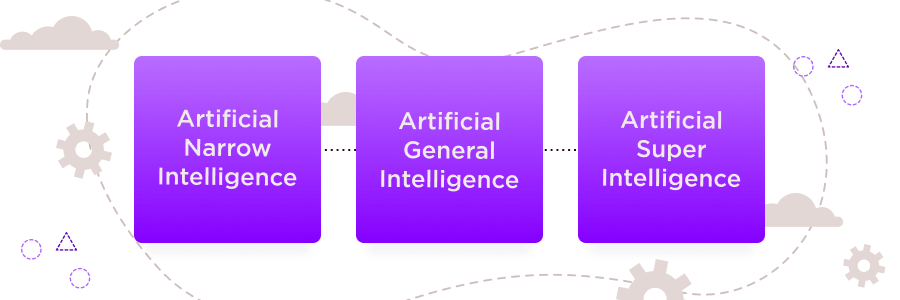
Now, let’s move on to the last types of AI solutions we’ll cover today. This third categorization is actually based on the previous one we discussed. Specifically, because you first develop an AI system based on its functionality (i.e., the second classification we’ve mentioned), which then results in it being known for a specific attribute or capability.
Thus, there are three main capability-focused types of artificial intelligence:
- Artificial Narrow Intelligence (ANI)
- Artificial General Intelligence (AGI)
- Artificial Super Intelligence (ASI)
Let’s quickly go over each one of them.
Artificial Narrow Intelligence (ANI)
Artificial narrow intelligence is also often known as “weak AI” or “narrow AI”. As the name implies, these devices perform very narrow, specific tasks and are thus largely based on reactive machines or limited memory AI models.
ANI systems are quite widespread in the current world and are actually the only types of artificial intelligence machines we’ve managed to create to this day. Things like facial and speech or voice recognition software, search engines, and digital assistants are all examples of goal-oriented ANI.
Moreover, in recent years, this type of AI has had multiple breakthroughs due to developments in the areas of machine learning and deep learning. For instance, these tools can now be used in fields like healthcare to diagnose disease with utmost accuracy thanks to human-like cognition.
So, even though the name may not paint the most compelling picture, these solutions are highly intelligent and are already bringing immense benefits to businesses and individuals from across the world.
Artificial General Intelligence (AGI)
Artificial general intelligence is also sometimes referred to as strong or deep AI, and it relates to machines that are able to mimic human intelligence and behavior. Specifically, these solutions possess the ability to learn and apply their judgment to solve problems in a way that is indistinguishable from humans.
AGI is based on the theory of mind framework that we’ve discussed previously and is thus all about developing software that can truly understand humans. Needless to say, this type of AI has not yet been achieved, but researchers are hard at work trying to build machines that are conscious and hold cognitive abilities.
Artificial Super Intelligence (ASI)
Finally, artificial super intelligence is the category that covers immensely powerful, hypothetical machines that are completely self-aware and actually surpass human intelligence. Thus, these solutions, if ever developed, would outperform us in pretty much all areas. Math, science, medicine, art, you name it.
As you can imagine, creation of such powerful software may generate a multitude of unknown consequences that we can only speculate about. So, in the meantime, we think it’s best to focus on those that can actually complement human abilities as opposed to totally rivaling them.
The Future of AI for Businesses
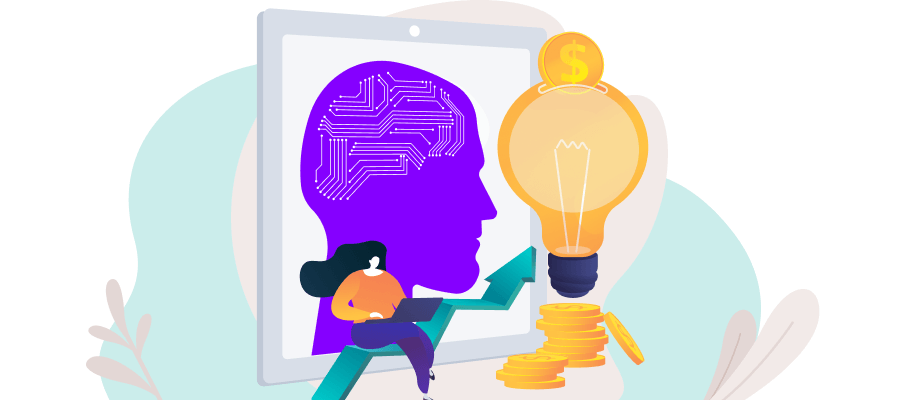
Now that you’ve got a better idea about the various AI types that either already exist or are, for now, only products of our imagination, you might be wondering what the future of AI in business looks like.
Well, as we’ve mentioned, the artificial intelligence machines we have in the world today are mainly from the ANI category. Hence, the majority of the progress will remain within this AI type in the near future.
According to Deloitte, artificial intelligence has shifted from being a “cherry-on-top” to a “key ingredient” in the majority of leading organizations. The high demand for artificial intelligence companies just approves it. So, there’s no longer any debate about the importance of this technology for businesses from all kinds of industries.
We couldn’t agree more and, based on the client requests we’ve been receiving, it seems that the near future is going to be all about perfecting AI algorithms to deliver the highest levels of accuracy and efficiency.
As discussed in the first categorization, automating processes across departments, extracting valuable insights from myriads of data, and perfecting customer service and sales calls will be the areas that see the highest levels of AI growth.
Learn more about the Invaluable Role of AI in Sales
The truth is, many think of machine intelligence as something to be feared, but, in the current context, it’s rather something that should be embraced and thought of as a partner that helps carry out tasks with better accuracy and efficiency. So, AI won’t necessarily replace workers, rather provide them with a new tool to rely on and free up time to focus on more creative, strategically important tasks.
GenAI for Business
Watch our webinar to uncover how to integrate GenAI for improved productivity and decisions.
Embracing AI Software Development
As you can see, there are many types of AI that fall under the various categorizations we outlined today. Yet, we’re clearly only at the cusp of realizing its full potential for businesses.
At Velvetech, we understand that it can get overwhelming to discern all the emerging technologies that are out there and identify the ones that can bring real value to your business. So, we make sure to start any of our AI software development services with a thorough analysis of your company’s needs and existing capabilities. Thus, ensuring that you acquire solutions that bring results and boost your bottom line.
Don’t hesitate to reach out to our team if you would like to discuss a potential collaboration or an AI project idea you have in mind. We’ll be happy to consult you on the best types of artificial intelligence that suit you and the ways that this technology can help your organization grow.
